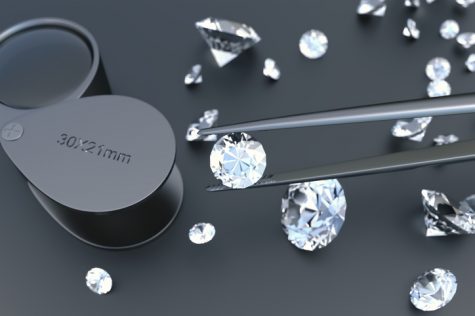The future of jewelry?
October 24, 2019

New lab-grown diamonds – yes, diamonds created in a lab – have been recently introduced into stores around the world and are starting to become somewhat of a trend in fashion and business. Though word has slowly gotten out about these ‘fake rocks,’ the idea of creating a diamond from scratch has been an idea and inspiration for many since the 1940’s, where they were used for industrial purposes.
Lab grown diamonds are better known today as synthetic diamonds, or engineered or cultured diamonds. The growing process is simulated in a scientifically advanced technological process that runs the stone through its natural transformation at an accelerated rate. A common comparable metaphor is “test tube” babies, as their process is started in a lab but grown biologically organic.
Completely indistinguishable from real diamonds, these cultured diamonds are made from pure carbon and can be made to exact measurements and sizes as one desires. Natural and lab grown diamonds are both 100% carbon; when formed in the ground they are formed at high temperatures and high pressure close to the earth’s core.
This same process can be re-created in a growth chamber that starts as a diamond seed. Under high temperature and pressure, carbon atoms release gas inside the chamber that build on top of the seed. This process can take as little as a month to make.
The only issue with growing lab diamonds is that once the seed is in the chamber there is no way of ‘checking in’ to see what is growing. People simply have to guess and see how large the diamond is after they make an educated guess to create a certain size.
Brilliant Earth is one of the first companies founded on the basis of bringing premier synthetic diamonds to the general public at a cost that’s only the fraction of what an identical natural diamond would cost. Their reasons why someone should choose a cultured diamond over a natural one include that there is no mining involved, which helps limit environmental degradation, along with taking the danger out of humans working in those environments.
Most if not all lab grown diamonds tend to be GIA (Gemological Institute of America) certified, which qualifies it as a diamond scientifically. The only difference in natural and cultured diamonds is the price. Lab grown diamonds are much less expensive than a natural diamond, which can be forty percent less expensive. Scientists are able to create type II diamonds, which account for about two percent of all diamonds in the world, making them extremely rare and identical to a natural diamond of the same size and much cheaper.
The biggest question people have is whether the public will want to purchase diamonds like this. Purists may not want to get involved with what they believe to be “fake” or “not original,” though after learning about the growth process, there are many large gem collectors that admit to purchasing and enjoying their GIA certified diamonds.
One would be foolish to pay full price for a diamond they could buy for less than half the price. The main reason you would want to look into lab grown diamonds would be purchasing colored diamonds, which are some of the rarest gems in the world and have price tags up to millions of dollars. For example, a 3 carat pink diamond would normally cost someone around $1 million, though with lab grown diamonds the same gem would cost you less than a quarter million dollars.
It also helps the U.S. economically by lowering import costs, as citizens will now be purchasing from American companies. According to the US International Trade Commission, U.S. diamond imports totaled over $21 billion in 2017. Not having to import as many diamonds will help to stimulate our economy more and help the government with more people being able to purchase these luxurious gems.














